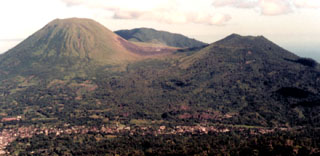Report on Lokon-Empung (Indonesia) — August 1994
Bulletin of the Global Volcanism Network, vol. 19, no. 8 (August 1994)
Managing Editor: Richard Wunderman.
Lokon-Empung (Indonesia) Description of fumaroles in the active crater
Please cite this report as:
Global Volcanism Program, 1994. Report on Lokon-Empung (Indonesia) (Wunderman, R., ed.). Bulletin of the Global Volcanism Network, 19:8. Smithsonian Institution. https://doi.org/10.5479/si.GVP.BGVN199408-266100
Lokon-Empung
Indonesia
1.3644°N, 124.7992°E; summit elev. 1580 m
All times are local (unless otherwise noted)
"During our visit to the summit zone on 8 July, intense fumaroles escaped from several parts of the Tompaluan crater floor. This fumarolic activity was mainly concentrated in the N where an intracaldera structure was covered by yellow sulfur deposits. Many other fumaroles with sulfur deposits were also located in the S, E, and W parts of the crater. Temperatures measured with an electronic thermometer at the E fumaroles showed a maximum value of 95-96°C. The fumarolic gases were mainly composed of H2O and H2S."
Geological Summary. The Lokong-Empung volcanic complex, rising above the plain of Tondano in North Sulawesi, includes four peaks and an active crater. Lokon, the highest peak, has a flat craterless top. The morphologically younger Empung cone 2 km NE has a 400-m-wide, 150-m-deep crater that erupted last in the 18th century. A ridge extending 3 km WNW from Lokon includes the Tatawiran and Tetempangan peaks. All eruptions since 1829 have originated from Tompaluan, a 150 x 250 m crater in the saddle between Lokon and Empung. These eruptions have primarily produced small-to-moderate ash plumes that sometimes damaged croplands and houses, but lava-dome growth and pyroclastic flows have also occurred.
Information Contacts: H. Gaudru, C. Pittet, M. Auber, C. Bopp, and O. Saudan, EVS, Switzerland.

